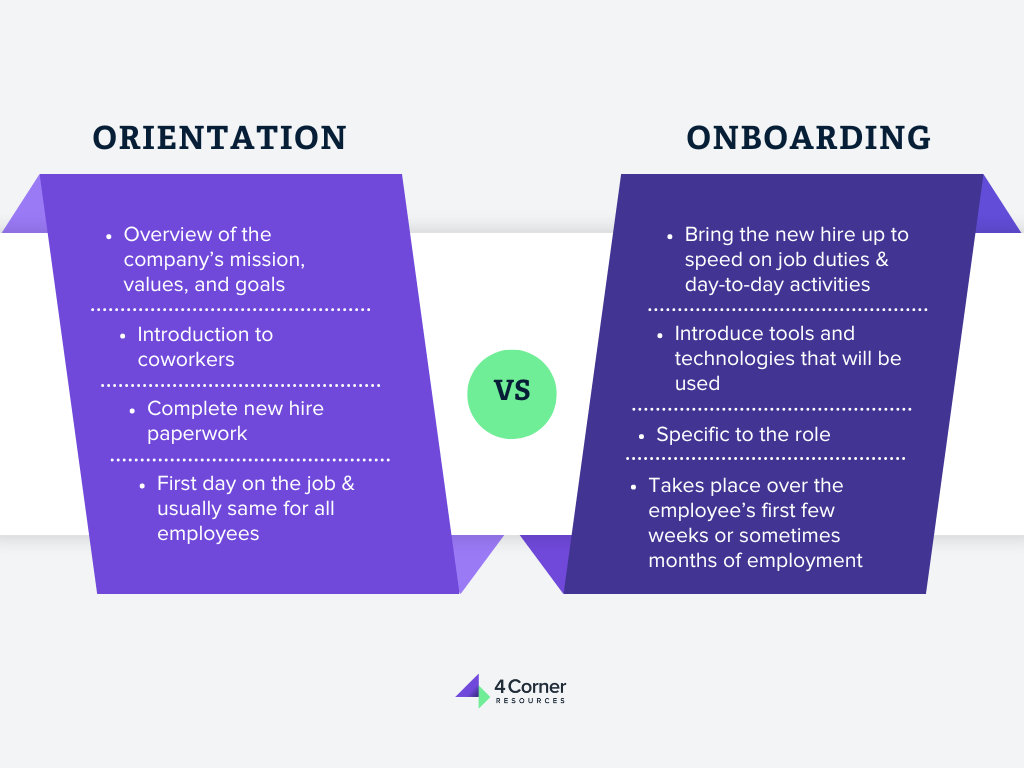How to Use Employee Orientation to Set New Hires Up for Success

Employee orientation onboards new hires to a company and lays the groundwork for a long and productive tenure there.
Standardizing the employee orientation process is an incredibly important step if you want to retain workers and ensure their success. Research by the Aberdeen Group found that 54% of companies with a formal onboarding process experience greater new hire productivity, while 50% see increased retention.
We’ll explain what goes into an effective employee orientation process and share tips for making the most out of a new hire’s first few hours on the job.
What Is Employee Orientation?
Employee orientation is a structured process for introducing new employees to the company and helping them acclimate to their workplace. The purpose of employee orientation is to:
- Make new hires feel welcome
- Acquaint them with their fellow team members
- Educate them on company policies
- Complete important paperwork
- Answer any outstanding questions they may have
Employee orientation is a collaborative effort between HR, the hiring team, and the department that the new hire will be joining. It’s conducted for every new employee regardless of their position and precedes any onboarding done at the team level, like training specific to the role.
The Difference Between Orientation and Onboarding

Though the terms ‘orientation’ and ‘onboarding’ are sometimes used interchangeably, there are some noteworthy differences. While they’re both important aspects of the new hire experience, they comprise different activities and accomplish different goals.
Employee orientation is an introduction to the workplace. It includes an overview of the company’s mission, values, and goals, introductions to key coworkers, and completing new hire paperwork. It typically only lasts for the worker’s first day on the job and is usually the same for all employees.
Onboarding, on the other hand, is a process that brings the new hire up to speed on job duties, tools and technology, and the day-to-day activities of their department. It’s specific to the role and takes place over the employee’s first few weeks or sometimes months of employment.
Why Is Employee Orientation Important?
Employee orientation has many benefits for new workers and the companies they’re joining. Here are a few of the big ones.
Sets a positive tone
A well-planned orientation kicks off the employee-employer relationship on a high note. It helps create a positive employee experience from day one, which is important for worker longevity, employer brand building, and future recruiting efforts.
Capitalizes on new hire momentum
Getting a new job is exciting, and new hires are typically eager to hit the ground running. Nothing kills that enthusiasm faster than a dark room and a sexual harassment training video made in 1984. On the other hand, a well-crafted employee orientation can help you take advantage of your new recruit’s excitement and parlay it into a successful first few weeks on the job.
Find the perfect fit for your team.
Speak to one of our recruiting experts today.
Shares important information
Orientation is an effective way to ensure that all new hires receive the necessary details. Use it to share important information like your company policy on harassment and the expectations for how employees will conduct themselves while at work.
Helps ensure a smooth transition
When new hires receive an orderly orientation, they tend to feel calmer about starting their new jobs. This can give them the confidence boost they need to succeed in their role and help them reach full productivity faster.
Provides structure
Approaching new employee orientation in the same way takes pressure off managers, who can devote their attention to providing clear goals and direction to their new reports. Systematizing the process allows you to fine-tune it over time, making your orientation as effective as possible.
Types of Employee Orientation
Employee orientation can take various forms depending on the company’s hiring volume and structure. Here are the main types of orientations.
Conference style
This is the most popular format for businesses onboarding multiple new employees weekly. It’s conducted by a leader in a large group setting, like a conference room or auditorium, and might include interjections from other speakers or videos to deliver different pieces of information.
Virtual
A growing trend in employee orientation is virtual orientation. This format is ideal for companies that hire remote workers or want to allow employees to accomplish new hire activities ahead of their start date. Virtual orientation allows workers to go at their own pace, working through digital materials like downloads and videos as their schedule allows. This format is useful for maintaining strong engagement between an accepted offer and a start date.
Small group/individual
If you hire a lower volume of employees, a small group or one-on-one orientation setting may be the preferred option. This more intimate format allows you to get to know new hires more closely and answer specific questions they may have. It also allows for new employees to build camaraderie amongst themselves.
How Long Should Employee Orientation Last?
Employee orientation should range from a few hours to a full workday. Avoid spreading your orientation over multiple days, as this can be frustrating for new employees who are eager to get started on the work they were hired to do.
Note that employee orientation is different from role-based onboarding, which is more tailored to a new hire’s specific job and may take longer.
What to Include in Employee Orientation
Here are some key components of a solid employee orientation program.
Completion of new hire paperwork
While it’s the least exciting part of starting a new job, filling out some paperwork is par for the course. Knock out all the essential documents like tax forms, confidentiality agreements, and non-compete contracts. Provide documentation on any benefits available to your new workers, like health insurance or stock options, and have them signed if necessary.
If you want to save time and skip this usually boring part of orientation, email paperwork in advance and have new hires complete it before arriving on their first day.
Related: New Hire Checklist
Overview of company policies
Provide new hires with your employee handbook and review the most important items. Good topics to cover include harassment and anti-discrimination policies, leave policies, and safety measures.
Introduction to colleagues
Give new hires a chance to meet the people they’ll be working with the most frequently. Many companies do this over a group lunch, which is a great opportunity for a new addition to get to know their colleagues in an informal setting. Consider pairing new hires with an orientation ‘buddy’ within their department who can serve as the point person for their first-week questions.
Workplace tour
Show your new hire around the office, building, or campus, identifying points of interest like vending machines, restrooms, and any amenities like an on-site gym. Set them up at their workstation and provide the login credentials they’ll need to access their company-issued devices.
Initial assignments
The biggest complaint of new employees when starting a job is a need for more direction. While some uncertainty is to be expected, you can help set new hires on a clear path from day one by giving them an assignment to start working on. This might be something small like a low-stakes task on a team assignment or a long-term project that they can begin planning toward.
Employee Orientation Checklist
- Company introduction
- Work hours
- Dress code
- Code of conduct
- Employee handbook
- New hire paperwork
- W-4 federal and state tax withholding forms
- I-9 employment eligibility verification
- Emergency contact information
- Direct deposit and payroll forms
- Benefits information
- Any other employer- or state-specific documents
- Introduction to colleagues
- Announcement of their arrival via email
- Pairing with an “orientation buddy” who can answer questions
- Tour of the office
- Set up workspace
- Handoff of login credentials
- Review schedule, what to expect in the coming weeks
- Assign the first project
- Answer questions
Tips for Conducting an Effective Employee Orientation
Follow an agenda
If you’ve ever sat through a play that ran a little too long, you know the value of a clearly outlined program. Providing and following an agenda lets new employees know exactly what to expect, which can help them focus and minimize first-day jitters.
Start before their first day
The most effective employee onboarding process starts well before the employee shows up to work for the first time; rather, it’s more like a seamless continuation of the hiring process. As soon as you’ve agreed on a start date, get the ball rolling on the necessary paperwork, send copies of documents that require a signature via email, and do what’s needed on your end to get their login and security credentials ready so you don’t lose time on your new hire’s first day.
Related: New Employee Welcome Letter Template and Tips
Change up the format
To avoid losing your new hires’ interest during a day-long orientation, it’s a good idea to switch things up at least once or twice. Use a combination of written materials, video, and face-to-face onboarding sections. Move between a few different locations to avoid it feeling like one endless meeting. Consider incorporating an ice-breaker or team-building exercise to give recruits a chance to talk amongst themselves.
Involve their team
Orientation shouldn’t fall solely on an HR staffer with whom the employee spends their first day and then rarely sees again. Incorporating the people your new employee will be working with regularly, especially their direct manager, makes more sense and will help ensure a smoother transition. This can set them on a path for a strong manager-report relationship.
Related: How to Involve Employees in the Hiring Process
Build in opportunities to engage
It is a mistake if your new hires spend most of their first day sitting silently, listening to other people speak. Give them opportunities to talk and engage, both with orientation leaders and their new peers. This interaction builds positive emotions and helps new workers feel like part of a team from day one.
Gather feedback
Don’t miss the opportunity to continuously improve your orientation process. After new hires have had a few weeks to settle into their roles, send a feedback survey to learn what they liked and what could be improved about the orientation experience.
What Not to Do During Employee Orientation
Don’t throw them into the deep end
If you don’t have a formal orientation process, make it your top priority to set one up ASAP. Suppose an employee shows up on their first day and is expected to start working without any organized welcome. In that case, they’re likely to feel alone, adrift, and uncertain about expectations, not to mention their choice to take the job.
Don’t overdo it
Avoid using your orientation to unleash a firehose of information or introduce new employees to so many people they’ll never remember who’s who. Getting acclimated to a new company takes time; it’s not something you can force to happen in a single day, no matter how great your orientation is. For many companies, half a day is a sufficient amount of time and will keep the experience from overwhelming.
Don’t forget to explain your business
It may seem obvious but don’t assume that everyone you’ve hired thoroughly understands your operations, products, and customers. For example, someone who was hired for IT maintenance may have only a basic knowledge of the company’s product offering. Build engagement by giving an overview of how the business works, who you serve, and what you aim to achieve.
By creating a structured, intentionally planned employee orientation process, you’ll help recruits feel welcome while giving them the tools and confidence they need to start off strong in their new roles.
